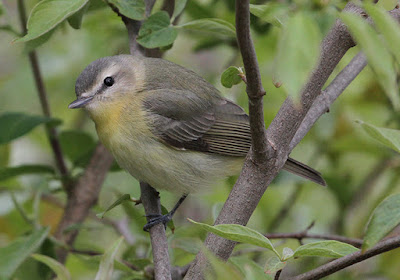 |
| Northern Parula offering great looks at eye level along the Magee Marsh boardwalk. |
On the boardwalk at Magee Marsh and in many other stopover areas, American Redstart (as well as breeders such as Common Yellowthroat and Yellow Warbler) remain the most prolific species. But Tennessee, Magnolia, Northern Parula, and Chestnut-sided Warbler can still be found in small numbers. Other birds showing very well have been Common Nighthawk (often roosting in the open near the east entrance of the Magee Marsh boardwalk), White-crowned and White-throated Sparrow at the feeders at Black Swamp Bird Observatory, Veery, Swainson's Thrush, Gray-cheeked Thrush, and a new arrival of shorebirds.
The Boss Unit of Ottawa National Wildlife Refuge and the wildlife drive through Ottawa have produced Marbled Godwit, Wilson's Phalarope, Red Knot, Semipalmated Plover and Sandpiper, Least Sandpiper, and a pair of Cattle Egret. Larger shorebirds such as Marbled Godwit may move around between suitable habitats, but won't typically stick around too long (so this bird may be on the move soon). But smaller shorebirds can be expected to hold to the same area for a few days.
Based off of numbers from Black Swamp Bird Observatory's Navarre Marsh Banding Station, the northwest Ohio region has yet to see a normal push (in terms of numbers of birds) from Magnolia Warbler, American Redstart, Red-eyed Vireo, and the thrushes. It's difficult to say whether these birds are still being delayed in their migration or whether they skipped over the Lake Erie marshes completely. We won't know until the next wave of birds arrives. But if migration has been delayed, we could expect to see a good number of birds and species in the upcoming days.
 |
| Yellow-bellied Flycatcher - one of the least confusing of the Empidonax flycatchers. |




